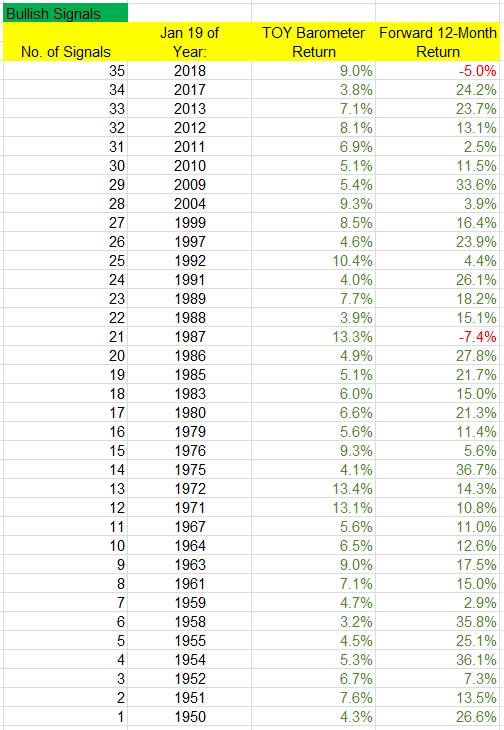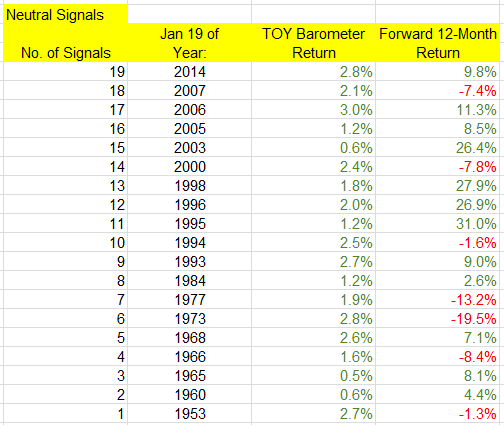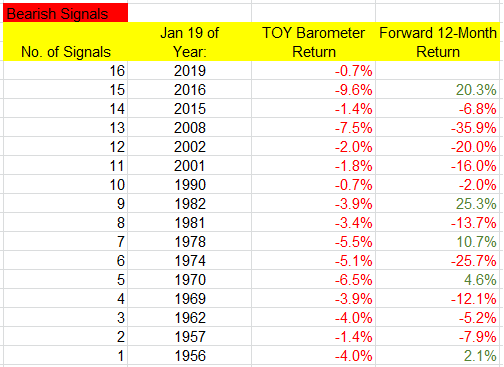This is an update of the November 26, 2018 report, where Wayne Whaley’s TOY Barometer was discussed. It’s Whaley’s top indicator, and now that new data is available, it’s worth seeing how last year played out and what’s likely in store for next year.
—————
Not a Leavitt Brothers subscriber but appreciate our work? Consider making a small donation.
—————
Mr. Whaley was a quant before quants existed. He has a math background and has been managing money since the late 1980’s.
He considers the TOY Barometer to be the single most reliable seasonality barometer of forward stock market returns – so much so that he’s said if he could only make one trade/year based on one indicator, this is the indicator he’d use.
Whaley’s goal was to identify what he called the “kingpin of seasonal barometers.” He stated: “I implored my computer to take a few seconds to exhaustively study S&P performance over every time period of the year and determine which time frame’s behavior was proprietor of the highest correlation coefficient relative to the following year’s performance.”
What he found was there was a high correlation between the S&P 500’s returns between November 19th and the following January 19th and the S&P’s performance the 12 months following January 19. And since the 2-month period straddled the turn of the year (TOY) and the gift giving season, he called it the TOY Barometer.
Specifically, the period studied is November 20 – January 19 (if Nov 20 is on a weekend, use the Monday after the weekend, and if Jan 19 is on a weekend, use the Friday before). He only considered the price-only return (no dividends).
If the return during this 2-month period was greater than 3%, a bullish signal was given, and the market was very likely to do well over the following 12 months. If the return was 0-3%, the signal was considered neutral, and results were somewhat random and in line with what is considered average. And if the return was negative, a bearish signal was given, and returns tended to be very poor.
Since 1950, there have been 35 bullish signals, 19 neutral signals and 16 negative signals (including the one that is currently live). Let’s look at each signal group.
Bullish Signals
The 35 bullish signals have led to gains 33 times the following 12 months. The losses were in 1987, the year of one of the biggest single-day crashes in history, and 2018, the year that just completed. I did a write-up discussing 2018 being the year the quants got destroyed. Add this study to the list because although a bullish TOY signal was given, a -5.0% loss followed.
The average and median gains of the 12 months following the bullish signals were 16.3% and 15.0%. Here are the stats.

Neutral Signals
There have been 19 neutral signals. The following year was positive 12 times (63%) and negative 7 times (37%). The overall average and median returns were 6.0% and 7.1%. But among the “up” years, the average and median gains were 14.2% and 9.4%, while the “down” years’ average and median losses were -8.5% and -7.8%. There were several big up years (1995, 1996, 1998, 2003), and two big down years (1973, 1977), so even if there is a neutral signal, there’s still a decent chance the following 12 months will venture far from its January 19 print. Here are the stats.

Bearish Signals
There have been 15 bearish signals (not including the current year). Only 5 of the following years posted a gain while 10 posted losses. And 6 of those 10 posted double digit losses. The overall average and median returns were -5.5% and -6.8%. The “up” years posted average and median gains of 12.6% and 10.7%, while the “down” years posted average and median losses of -14.6% and -12.9%. Here are the stats.

Here’s a table summarizing the stats.
The bullish years have a very high win rate (94% vs 72% for “all years”). The gains are close to the “all” years gains (17.7% vs 16.4%), so just because there’s a bullish signal, the gains aren’t much better than average.
The bearish years have a low win rate (33%). The gains during those up years (12.6% vs 16.4% for all years) aren’t bad, while the losses during the down years are noticeably bigger than when a bullish or neutral signal is offered (-14.6% vs -6.2% for bullish years and vs -8.5% for neutral years).
The neutral years are mixed. The win rate is 63% (vs 72% for “all years”), with the gains during up years being pretty good (14.2% vs 16.4% for “all years”) and the losses during down years being moderate (a little worse than bullish years but much better than bearish years).
In summary, most notable – and yes this table is a little confusing – is the following: When a bullish signal is in play, odds heavily favor solid gains over the following 12 months, but when there’s a bearish signal, odds favor a down year with a relatively big loss.

The current signal is bearish. The S&P moved from 2690.73 to 2670.71 for a 0.74% loss. A TOY barometer return below 0 has occurred 15 previous times since 1950. The following 12 months have been up 5 times and down 10 times. During the up years, the average gain has been 12.6%, and twice the S&P has rallied more than 20%. But during the down years, the average loss has been 14.6% with three losses more than 20% and six losses greater than 10%.
Odds favor the bears for the 12 months following January 19 of this year.
It’s also worth looking at what happened following the failure of the indicator to fulfill in 1987 because it was the only other time a bullish signal failed.
The TOY barometer was bullish the following two years, and the market followed through and posted solid gains too. So failure to fulfill doesn’t necessarily imply something is wrong.
For now we’re on a bearish signal…for whatever that’s worth.
Jason Leavitt
11 thoughts on “Wayne Whaley's TOY Barometer – an Update”
Leave a Reply
You must be logged in to post a comment.
Good article. What the search has turned up is the equivalent of a 2 MA crossover system with a long time period (months). The way the data is represented is just another conformal mapping. Different vegetable dressing, same taste.
I like your work.
George
Well that is certainly different. Thanks for sharing that with us.
Thanks Jason,
Interesting data…. we will see what happens in the next 12 months.
Worth noting and can trade accordingly. But nothing takes the place of good chart analysis.
all the best in 2019
Jack
I agree. These kinds of stats hold up over many decades, but year to year anything can happen.
Interesting relationship between Nov 19 – Jan 19 and the year. I assumed I would have to trade 2019 and not just sit on my stocks all year.
I agree with Jack – nothing takes the place of good chart analysis.
Jason:
If I add to my current subscription, what will be added besides
what I get now?
Sincerely,
Reed Bryant
Hi Reed…I emailed you.
A credible reference article with excellent stats, I’ll be paying attention to this one. Thanks, Jason.
Jason….as always, a very informative analysis using past data over a number of years.
If the $SPX was 2641.89 on 11/20/2018 and 2670.71 on 01/19/2019 for a positive $DELTA of $28.82 or 1.09%, then how do you get a negative 0.70% change referenced in the article? Must be something simple that I am missing. Can someone set me straight? Thanks. Jim
In order to “capture” the November 20 data, you have to use the November 19 closing print, which was 2690.73.
If you use 2641.89, you’re not using November 20 as your starting point.